Getting rid of yellow teeth includes natural and dental remedies. Natural remedies include apple cider vinegar, lemon, orange, banana peels, baking soda, hydrogen peroxide, and coconut oil pulling. Vitamin C intake and eating fruits and vegetables with a high water content are other ways to get rid of yellow teeth naturally.
Vitamin C intake from citrus fruits guards gums and teeth, prevents gum disease, and maintains oral health, while apple cider vinegar aids in whitening teeth. Rubbing lemon, orange, or banana peels on teeth is a natural remedy, while baking soda and hydrogen peroxide in toothpaste whiten teeth. Coconut oil improves oral health by removing bacteria and plaque.
Dental remedies for removing yellow teeth include frequent brushing, the application of whitening toothpaste, tray-based tooth whiteners, and activated charcoal. Whitening strips and rinses, dental veneers, and teeth whitening are the other dental remedies on how to fix yellow teeth.
Regular brushing twice daily maintains oral hygiene and prevents dental issues. Whitening toothpaste uses blue covarine to remove stains and lighten teeth. Tray-based tooth whiteners use peroxide-based gel. Activated charcoal treats yellow teeth by adsorbing plaque and stains. Whitening strips and rinses lighten teeth by at least two shades. Teeth whitening is a cosmetic dental procedure that removes stains and discolouration. Dental veneers conceal cosmetic imperfections, providing a natural appearance with proper care and oral hygiene.
Understanding the causes of yellow teeth helps identify lifestyle factors, maintain oral health, seek appropriate treatment, and choose safe remedies. It helps set realistic expectations for teeth whitening, prevent damage, and ensure the proper use of remedies. Understanding the remedies for yellow teeth helps prevent further discoloration, improve oral hygiene, and seek appropriate treatment options.
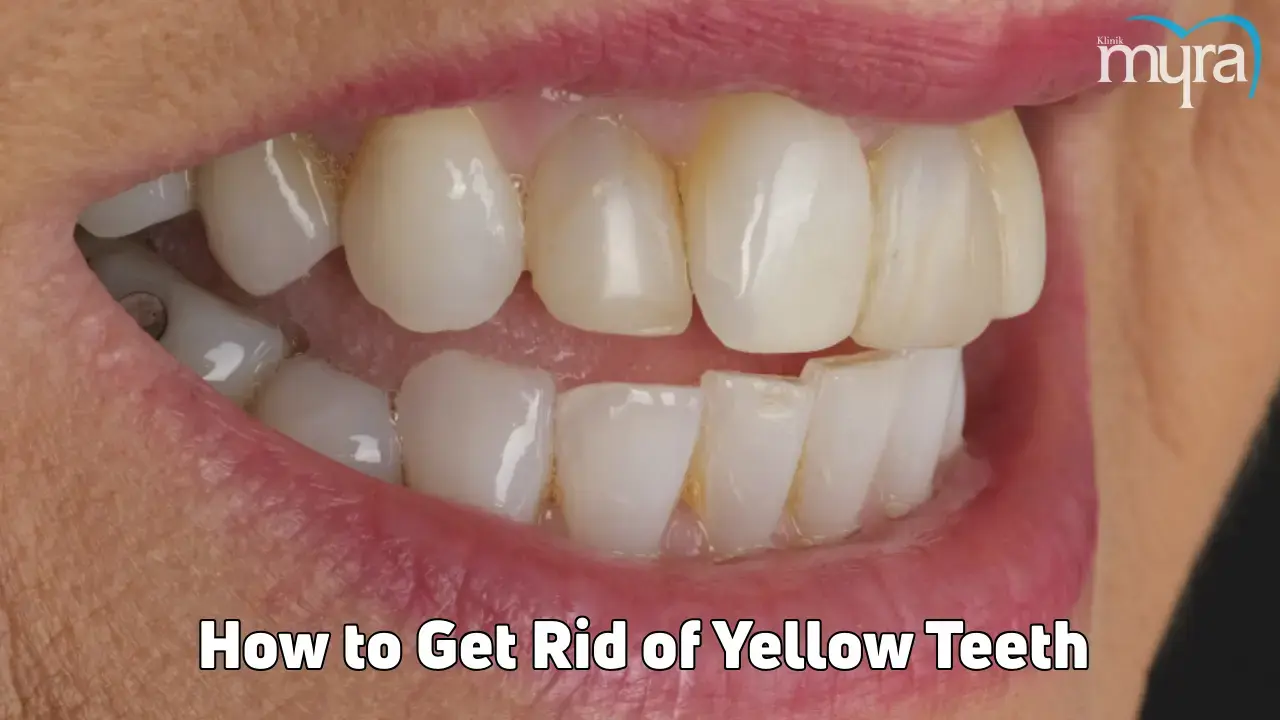
What are the Natural Remedies for Treating Yellow Teeth?
The natural remedies for treating yellow teeth are listed below.
- Vitamin C Intake: Vitamin C, derived from citrus fruits, protects gums and teeth from damage, prevents gum disease, and maintains oral health.
- Apple Cider Vinegar: Apple cider vinegar's acidic properties help whiten teeth in small amounts, breaking down plaque and surface stains. Continuous usage damages teeth in the long run.
- Lemon, Orange, or Banana Peels: Rubbing lemon, orange, or banana peels on teeth is a natural remedy for whitening teeth, but caution is advised due to the acidic nature of the fruit's peels.
- Baking Soda and Hydrogen Peroxide: Baking soda and hydrogen peroxide are used in toothpaste to whiten teeth, remove stains, and kill bacteria. Consistent use and good oral hygiene enhance the effect.
- Coconut Oil Pulling: Coconut oil pulling improves oral health by removing bacteria and plaque. Coconut oil's antimicrobial properties and moisturising effects vary.
- Eating Fruits and Vegetables with a Higher Water Content: Raw fruits and vegetables with a high water content help maintain teeth health by cleansing plaque and bacteria and increasing saliva production. It must be part of a comprehensive oral care routine.
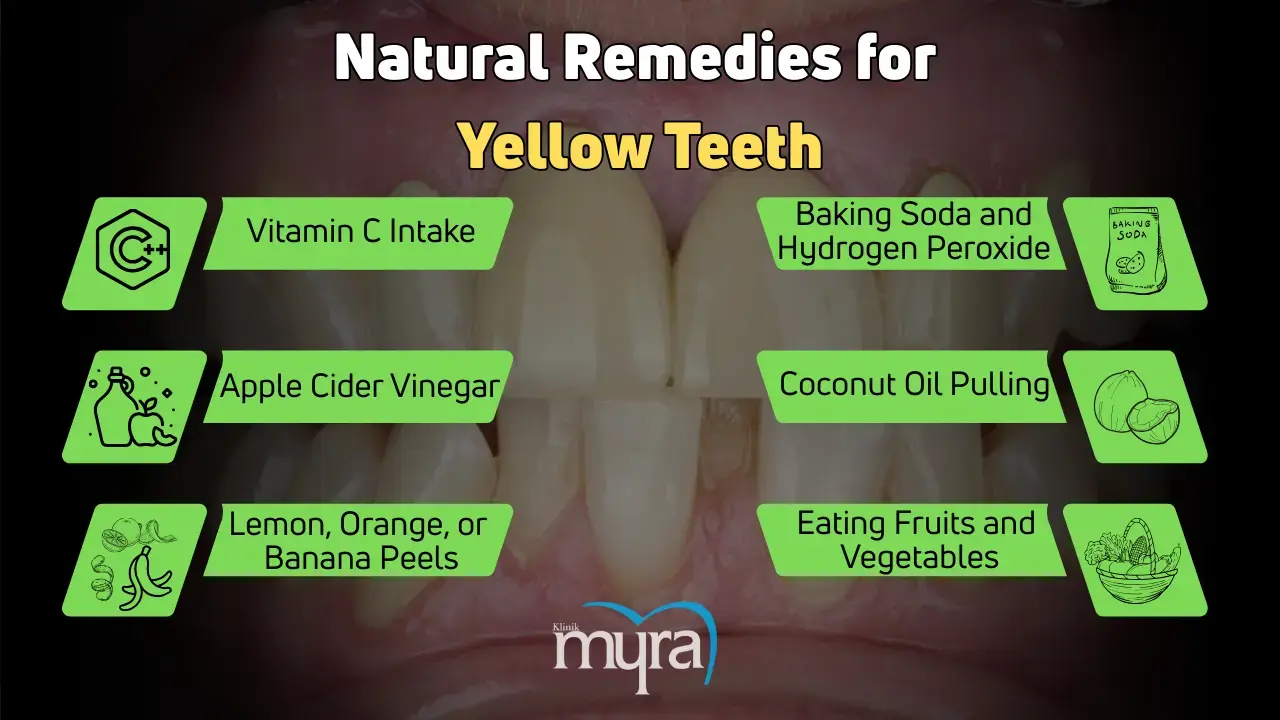
1. Vitamin C Intake
Vitamin C helps maintain health, preventing periodontitis and tooth yellowing due to bacterial buildup. It is derived from citrus fruits, strawberries, kiwi, bell peppers, broccoli, and spinach. Vitamin C's antioxidant properties protect the gums and teeth from damage caused by free radicals, preventing discolouration. Sufficient amounts of vitamin C help stave off gum disease, which leads to bleeding, receding gums, and inflammation of the gums.
Vitamin C improves oral health by repairing and growing tissues inside the mouth. It plays a preventative role by promoting healthy gums and preventing gum disease, indirectly supporting the maintenance of white teeth. Vitamin C is not a direct whitening agent and must be part of a broader oral hygiene routine. Specialised dental whitening treatments or dental consultations are recommended for effective treatment.
2. Apple Cider Vinegar
Apple cider vinegar (ACV) has been claimed to help whiten teeth in small amounts due to its acidic properties, which may help remove stains. The acidic nature of ACV helps break down plaque and surface stains, further leading to a whitening effect. It has antibacterial properties that reduce harmful bacteria in the mouth, promotes oral health, and prevent conditions that lead to tooth discolouration. The acidic nature of ACV helps remove superficial stains from substances, including coffee, tea, and tobacco. The whitening effect of ACV is short-term, and continuous use damages teeth in the long run.
3. Lemon, Orange, or Banana Peels
Rubbing lemon, orange, or banana peels on teeth makes them whiter. The natural remedy involves gently rubbing the inner portion of the peel for roughly 2 minutes, then thoroughly washing and brushing. Citric acid, found in citrus fruit peels, is believed to aid in whitening teeth. The acidic nature of the fruit erodes tooth enamel. Caution is advised when using the rubbing lemon, orange, or banana peels method.
4. Baking Soda and Hydrogen Peroxide
Baking soda and hydrogen peroxide are two natural ingredients used as toothpaste for teeth whitening. Baking soda is known for its abrasive effects, which remove stains from the tooth surface. Hydrogen peroxide is a natural bleaching agent that helps kill bacteria. Mixing baking soda and hydrogen peroxide creates a paste used to brush teeth regularly.
A study found that people who used toothpaste containing baking soda and hydrogen peroxide showed significant improvements after 6 weeks. Another review in 2017 concluded that toothpaste made with baking soda and hydrogen peroxide is effective and safe for removing tooth stains and whitening teeth. Consistent use and good oral hygiene practices enhance the whitening effect.
5. Coconut Oil Pulling
Coconut oil pulling is a traditional practice that involves swishing oil in the mouth to improve oral health and hygiene. It helps remove bacteria from the mouth that cause plaque and make teeth yellowish. There is no scientific evidence supporting the effectiveness of oil pulling for tooth whitening, but people who use it are satisfied with the results. A 2015 study found that oil pulling or swishing in the mouth with coconut oil effectively reduces plaque buildup on the teeth, contributing to yellowing.
Coconut oil pulling has antimicrobial properties, which help reduce harmful bacteria in the mouth and plaque buildup. It has a moisturising effect, keeping the gums and oral tissues healthy and hydrated. The effectiveness of coconut oil pulling for whitening teeth varies, with some people finding it mildly effective and requiring regular and prolonged use to see noticeable results.
6. Eating Fruits and Vegetables with a Higher Water Content
Eating raw fruits and vegetables with high water content helps maintain teeth health by cleansing them of plaque and bacteria that cause yellow teeth. Chewing on raw fruits and vegetables with high water content at the end of a meal increases saliva production, which helps remove food particles stuck in teeth and wash away harmful acids. Foods contribute to oral hygiene but are not a complete solution for everyone and must be part of a comprehensive oral care routine that includes regular brushing and flossing.
What are the Dental Remedies for Treating Yellow Teeth?
The dental remedies for treating yellow teeth are listed below.
- Frequent Brushing: Frequent brushing, done twice daily, maintains oral hygiene, prevents dental issues, and reduces plaque buildup and stains. Use fluoride toothpaste, a soft-bristled toothbrush, and an electric toothbrush.
- Applying Whitening Toothpaste: Whitening toothpaste uses blue covarine to remove coffee or smoking stains, lighten teeth, and reduce yellowing. Regular use over two to six weeks is adequate.
- Tray-Based Tooth Whiteners: Tray-based tooth whiteners use peroxide-based gel to lighten teeth, depending on concentration, duration, and dental condition.
- Activated charcoal: Activated charcoal, a porous carbon, effectively treats yellow teeth by adsorbing plaque and stains, but the long-term effectiveness and safety are limited.
- Whitening strips: Whitening strips are flexible plastic strips coated with peroxide-based whitening gel, used to remove stains and lighten teeth by at least two shades.
- Whitening rinses: Whitening rinses with oxidising agents lighten tooth colour by reacting with stain-producing compounds. Teeth are one to two shades lighter within three months, but whitening rinses are less effective than strips or professional treatments.
- Teeth Whitening: Teeth whitening is a cosmetic dental procedure that removes stains and discolouration, enhancing tooth appearance through sanding, bleaching, and ultraviolet light therapy.
- Dental Veneers: Dental veneers are custom-made shells that conceal cosmetic imperfections on teeth's front surfaces, providing a natural appearance and long-term solution with proper care and oral hygiene.
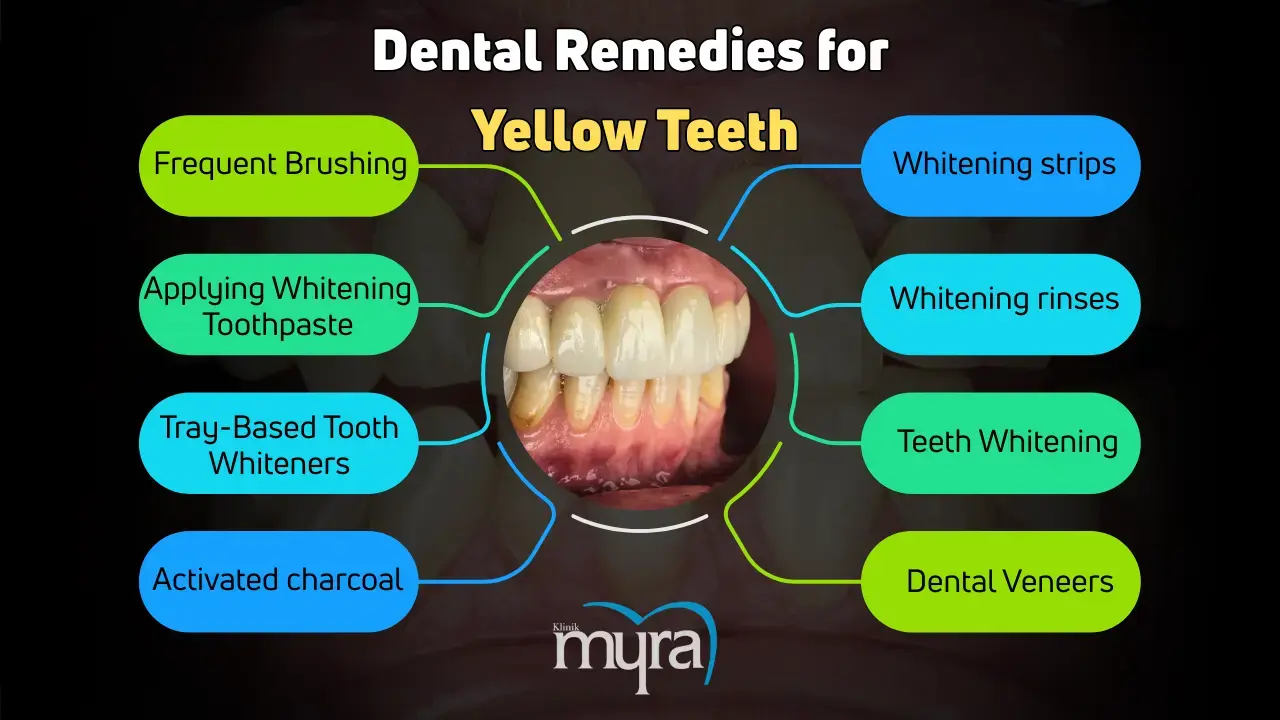
1. Frequent Brushing
Frequent brushing is a practice that involves brushing teeth more than twice a day, after meals or snacks, to maintain oral hygiene and prevent dental issues. The process involves gently brushing teeth in a circular motion, ensuring all surfaces are cleaned. It is important not to brush too hard or to avoid damaging enamel.
Frequent brushing helps treat yellow teeth by reducing plaque buildup and preventing stains from food and drinks. It is effective when done correctly after meals. There is no evidence that brushing more than twice a day is beneficial, as overbrushing leads to enamel wear and gum recession.
Tips for the best practice of brushing include brushing at least twice daily with fluoride toothpaste and a soft-bristled toothbrush to avoid damaging gums and enamel. The toothbrush must be placed at a 45-degree angle towards the gums to sweep away plaque effectively. Brushing must be done for 2 minutes, covering the surfaces of the teeth. Toothbrushes are replaced every three to four months or sooner if the bristles are worn out. Consider using an electric toothbrush to clean the tongue efficiently and brushing it to remove bacteria.
2. Applying Whitening Toothpaste
Whitening toothpaste has a unique formula to remove surface stains on teeth from coffee or smoking. It contains ingredients such as blue covarine that make teeth appear less yellow. Whitening toothpaste lightens stains and makes teeth appear whiter with regular use over two to six weeks.
The effectiveness of whitening toothpaste varies based on factors such as surface stains and intrinsic stains. Consistent use over several weeks is needed to see noticeable results. Whitening toothpastes are safe for daily use, but overuse leads to enamel erosion and increased tooth sensitivity. It is necessary to follow the manufacturer's recommendations and consult with a dentist if there are concerns.
3. Tray-Based Tooth Whiteners
Tray-based tooth whiteners are at-home dental treatments that use trays filled with a peroxide-based whitening gel. The trays are worn over teeth for 2 to 4 hours a day or overnight, causing teeth to lighten by one or two shades. The gel breaks down stains into smaller molecules, making them less concentrated and visible.
The effectiveness of tray-based tooth whiteners depends on the concentration of peroxide in the gel, the duration of the treatment, and the patient’s specific dental condition. Custom-fitted trays are more effective than over-the-counter options, but professional in-office treatments are more effective for deeper or stubborn stains.
4. Activated charcoal
Activated charcoal is a highly porous carbon treated to increase its adsorptive power and be highly effective in treating yellow teeth. It binds with substances such as plaque and surface stains on teeth, making them easier to remove. There is mixed evidence regarding its effectiveness, with sources suggesting that activated charcoal adsorbs plaque and other compounds that stain teeth, making it a natural teeth whitener.
Limited scientific evidence supports activated charcoal's long-term effectiveness and safety. Issues with activated charcoal include its abrasiveness, which wears down tooth enamel over time, leading to increased sensitivity and a higher risk of cavities. Dental professionals recommend using activated charcoal sparingly and cautiously and relying on proven whitening methods for more reliable and safer results.
5. Whitening strips
Whitening strips are flexible plastic strips coated with a peroxide-based whitening gel. Whitening strips are spread directly on the teeth's surface to remove stains and whiten. It aids treat yellow teeth using hydrogen peroxide or carbamide peroxide to bleach stains, which lightens teeth by at least two shades for the majority of people. Whitening strips work by adhering to the teeth, breaking down the molecules that cause stains, and removing the stains.
Whitening strips effectively treat yellow teeth and surface stains caused by food, drinks, or smoking. The effectiveness varies based on factors such as the type and concentration of the bleaching agent, the duration of use, and the type of stains. Several whitening strips use hydrogen peroxide to whiten teeth, and people using at-home teeth whitening expect to lighten teeth by at least two shades, while some get up to five shades lighter.
Over-the-counter whitening products contain lower concentrations of whitening agents, which reduce the risk of adversely affecting tooth enamel. Higher concentrations or overuse of whitening products damage enamel.
6. Whitening rinses
Whitening rinses are mouthwashes containing oxidising agents such as hydrogen peroxide that react with stain-producing compounds on teeth, helping to lift and lighten tooth colour. Regular use leads to a one to two-shade improvement in tooth colour within three months. Whitening rinses are effective but offer more subtle results than other whitening products.
Regular use allows the bleaching agents to continually work on the stains, lightening the colour of the teeth. Whitening rinses are considered less effective than other whitening products, such as strips or professional treatments, due to lower concentrations of bleaching agents, short contact time, and consistency of use.
7. Teeth Whitening
Teeth whitening is a cosmetic dental procedure that terminates pigments and discolouration to make teeth appear brighter and whiter. It involves diverse methods, including sanding down stains, bleaching, and ultraviolet light therapy. Bleaching agents such as hydrogen peroxide or carbamide peroxide break down stains and lighten tooth enamel.
The whitening process works best on surface stains but removes deeper stains with professional treatments. Teeth whitening effectively treats yellow teeth caused by food, drink, and smoking. The effectiveness of teeth whitening varies based on the type and severity of stains, the concentration of bleaching agents, consistency and compliance with instructions, and responses to whitening treatments.
8. Dental Veneers
Dental veneers are thin, custom-made shells that cover teeth' front surfaces to conceal cosmetic imperfections such as cracks, chips, and stains. Dental veneers cover stains and discolouration, providing a natural appearance and a long-term solution. It is opaque and matches the desired white shade, making it suitable for teeth that are deeply discoloured due to trauma, medications, or excessive fluoride exposure.
Proper diagnosis, preparation, and placement are needed for a natural look. Dental veneers last for many years with proper care, regular oral hygiene practices, and avoiding excessive force.
How much is a Dental Veneer in Turkey?
Dental veneers in Turkey cost £100 - £350 for a single tooth and £2,520–£5,400 for a complete set. The cost of veneers varies based on the type, materials, complexity of the case, and location of the dental clinic. Turkey's dental tourism is popular due to its affordable prices and advanced facilities, making it an attractive option for people looking to improve their smiles without breaking the bank. Packages included adding to the cost, such as treatment, x-rays, physician's consultations, and subsequent appointments.
Dental veneers in Turkey are a popular choice due to their low cost, which is two to three times less expensive than in Western countries, including the USA, UK, or Europe. The USA has the most costly veneer, with prices ranging from £210 to £2106 ($270-$2708). Veneers in the UK range from £400 to £1000 for a single piece of porcelain.
Dental veneer prices vary between Turkey, the UK, and the USA due to cost of living, operational expenses, insurance, and geographical location. Countries with lower living costs have affordable dental services, reflected in the lower operational expenses of dental clinics. Health insurance coverage impacts out-of-pocket costs for patients. Geographical location affects dental procedure prices, so dental veneers in Turkey are less expensive than in the UK or the USA.

What is Yellow Teeth?
Yellow teeth are a colour change caused by thin enamel, allowing the dentine underneath to show through. Causes of tooth discoloration include tobacco use, dental trauma, poor oral hygiene, and certain foods, drinks, and medications. Tartar forms when food and drink particles in plaque harden over time, and dentists or hygienists remove them. The yellow core becomes increasingly apparent as people age because the white enamel surface erodes.
Yellowing occurs when the outer enamel wears down or becomes stained due to acidic foods, aggressive brushing, or acid reflux. Regular dental care, including brushing and flossing, mouthwash, and regular dental visits, helps prevent tooth discoloration and offers treatments such as professional teeth whitening to address surface stains and discolouration.
How does Yellow Teeth Develop?
Yellow teeth develop due to enamel erosion revealing the yellow dentin beneath, combined with external staining from foods, drinks, tobacco, poor oral hygiene, medications, or genetic factors. External factors, such as the consumption of coloured foods and beverages, tobacco use, and poor oral hygiene practices that result in plaque buildup and staining, are responsible for yellow teeth. Internal factors include genetics, certain medications, illnesses, and the natural ageing process, which cause enamel wear and expose the yellower dentin underneath.
People wonder, "Why are my teeth so yellow?” The answer is that the enamel, the teeth's hard, white outer layer, has worn down, exposing the yellowish dentin beneath. Preventing discolouration requires regular dental care and avoiding stain-causing substances. Comprehensive oral care, including brushing, flossing, professional cleanings, avoiding staining foods, and quitting tobacco, helps prevent and mitigate tooth yellowing.
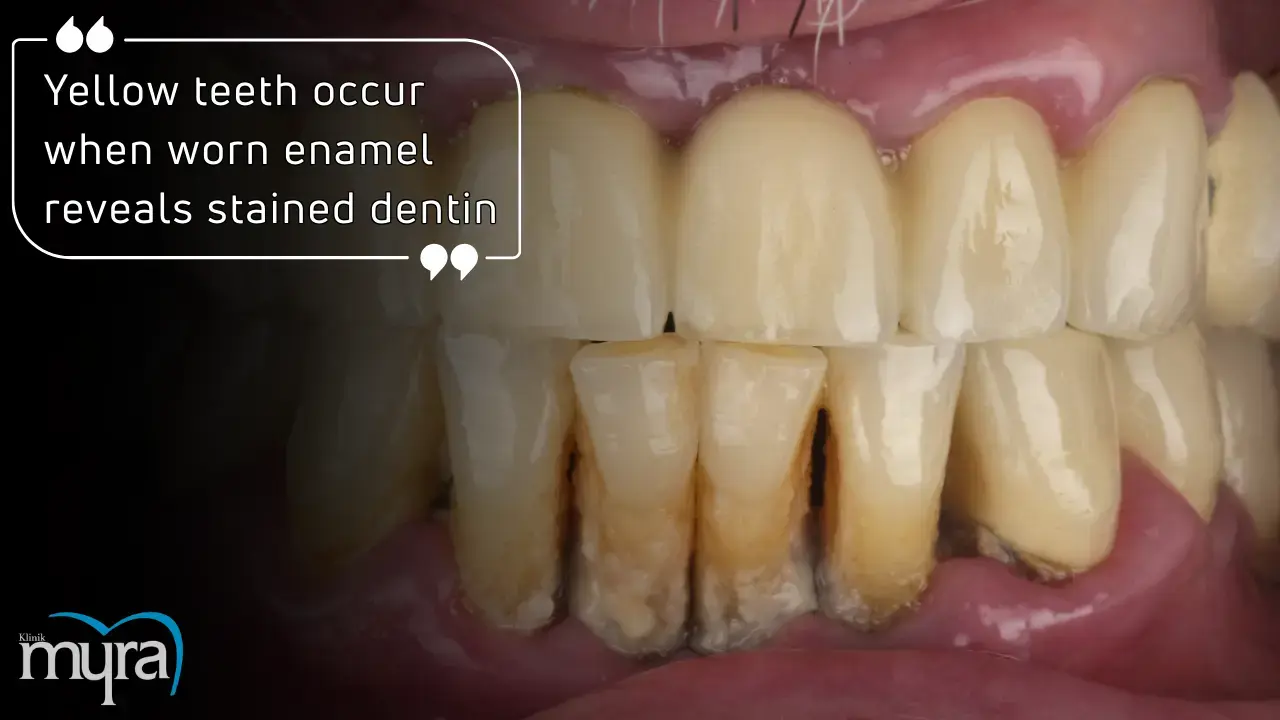
Is Yellow Teeth common?
Yes, yellow teeth are common. The enamel, the protective outer layer of teeth, naturally wears down over time due to chewing and exposure to acidic foods and drinks. People are exposed to elements contributing to yellowing, such as staining foods and beverages, tobacco use, and natural ageing processes leading to enamel erosion and dentin exposure.
Excessive yellowing indicates a tooth infection or poor oral hygiene. Good oral hygiene and regular dental check-ups are important for maintaining healthy teeth. Personalized treatment options and advice are provided by a dentist if a patient is concerned about the colour of teeth or asks if is yellow teeth normal. Good oral hygiene prevents severe discoloration or underlying dental problems, even though yellowing does not indicate a problem. Prolonged dental examinations, consistent brushing, and flossing help prevent severe discolouration.
What causes Yellow Teeth?
The causes of yellow teeth are listed below.
- Smoking: Cigarette smoke contains tar and nicotine, which causes yellow teeth. Tar, a sticky brown substance, leaves a residue on teeth and fingers, while nicotine, initially colourless, turns brown when reacting with oxygen. The porous nature of tooth enamel allows the substances to settle in, leading to discolouration, especially along the edges and gum lines. Research indicates that tooth discolouration is more evident among smokers than non-smokers.
- Genetics: Genetics influences tooth colour, brightness, and transparency and runs in the family. Inheritance of stain-prone teeth or inherently yellow enamel contributes to yellow teeth. Treatment options include whitening strips or toothpaste. Genetic conditions such as dentinogenesis imperfecta and amelogenesis imperfecta cause yellow or brown teeth due to gene changes. Enamel thickness affects colour, with thicker enamel being whiter and thinner enamel exposing dentin.
- Ageing: The outer covering of teeth, called enamel, thins and wears down with age, revealing more yellowish tissue called dentin underneath. It exposes the teeth to yellowing, a natural part of ageing. Ageing is associated with changes in saliva production and composition, affecting the teeth' ability to resist stains and maintain whiteness. Regular dental care, including professional cleanings and whitening treatments, helps mitigate the ageing effects and maintain a brighter smile.
- Drinks: Various beverages, including coffee, tea, red and white wine, dark and light sodas, and sports drinks with artificial flavouring, are the reasons why the teeth turn yellow. Acidic drinks roughen enamel, increasing the surface area and making it easier for colours from beverages to become etched onto teeth. Rinsing the mouth with water or using a straw minimises staining, and regular dental cleanings help remove surface stains.
- Excessive Flouride: Fluorosis is a condition in which teeth appear discoloured due to excessive fluoride intake from fluoridated water, toothpaste, and prescribed fluoride tablets and treatments. It leads to dental fluorosis, accumulating fluoride in teeth and causing chalky white patches on the enamel. The patches become yellow or brown, and the enamel appears mottled or pitted over time.
- Poor Oral Hygiene: Poor oral hygiene leads to tooth decay and stained teeth. Plaque buildup, a sticky bacteria film, forms on teeth when food and drink particles are not adequately cleaned. Plaque and tartar trap stains and waste products from bacteria, causing teeth to appear yellow and discoloured. Regular brushing, flossing, and dental check-ups help maintain white teeth.
- Food: Various foods, including tomatoes in pasta sauce, curry spices, berries, and balsamic vinegar dressing, stain teeth. The foods contain pigments that cling to tooth enamel, making stained or yellow teeth. A diet high in sugar and simple carbohydrates invites bacteria and discolours teeth.
- Dental Treatments: Dental treatments such as silver amalgam and root canal therapy cause tooth discolouration. Excess fluoride, antibiotics, and intrinsic stains cause tooth yellowing. Intrinsic stains caused by injuries, antibiotic use, fluoride, or genetics require dental bonding, porcelain veneers, or crowns. Proper treatment involves consultation with a dentist.
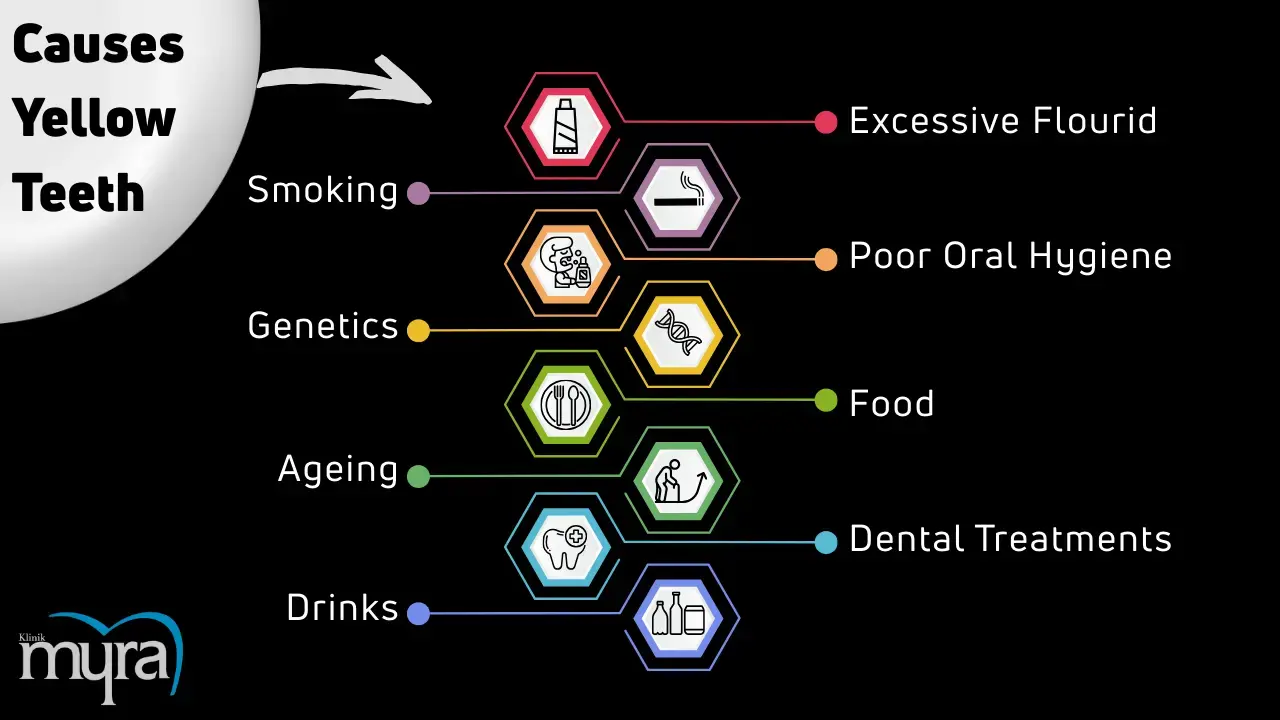
Is Yellow Teeth a part of Aging Process?
Yes, yellow teeth is a part of the ageing process. Teeth naturally become darker or yellow as people age because the enamel, or the outer layer of teeth, erodes. Teeth appear yellower due to wear that permits the yellowish dentin below to come through. Lifestyle factors such as smoking and dietary habits contribute to tooth yellowing. Maintaining proper oral care and scheduling routine dental exams helps to avoid additional tooth yellowing and maintain a brighter smile.
Age-related enamel layer thinning, enamel mineral loss, dentin changes, pulp chamber enlargement, decreased saliva flow, receding gum lines, and increased staining are the leading causes of teeth turning yellow. Teeth's enamel layer, which gives them white colour and protection, naturally thins over time due to eating acidic meals and plaque acids. Enlarging the pulp chamber makes the surrounding dentin walls thinner, allowing the darker pulp colour to show through more.
What are the Complications of Yellow Teeth?
The complications of yellow teeth include dental cavities, tooth wear, cracking, chipping, excess tartar buildup, swollen gums, tooth rot, and infection of the tissues and bone surrounding teeth. Yellow teeth are a sign of poor dental hygiene, which causes tooth decay and plaque accumulation. Bacteria that produce acids damage the enamel, causing cavities resembling yellow to black holes in teeth.
Dental cavities are decay-induced holes in teeth that result from incorrect plaque clearance. Teeth wear is the gradual loss of tooth structure resulting from mechanical or chemical processes, and yellow teeth have weaker enamel, which makes them more prone to wear. Swollen gums result from poor oral hygiene, leading to yellow teeth due to excess plaque and tartar at the gumline.
Tooth rot, or advanced tooth decay, occurs when cavities are left untreated, leading to severe pain, infection, and tooth loss. Advanced dental decay and gum disease lead to periodontitis, a severe gum infection that damages soft tissue and destroys the bone supporting the teeth.
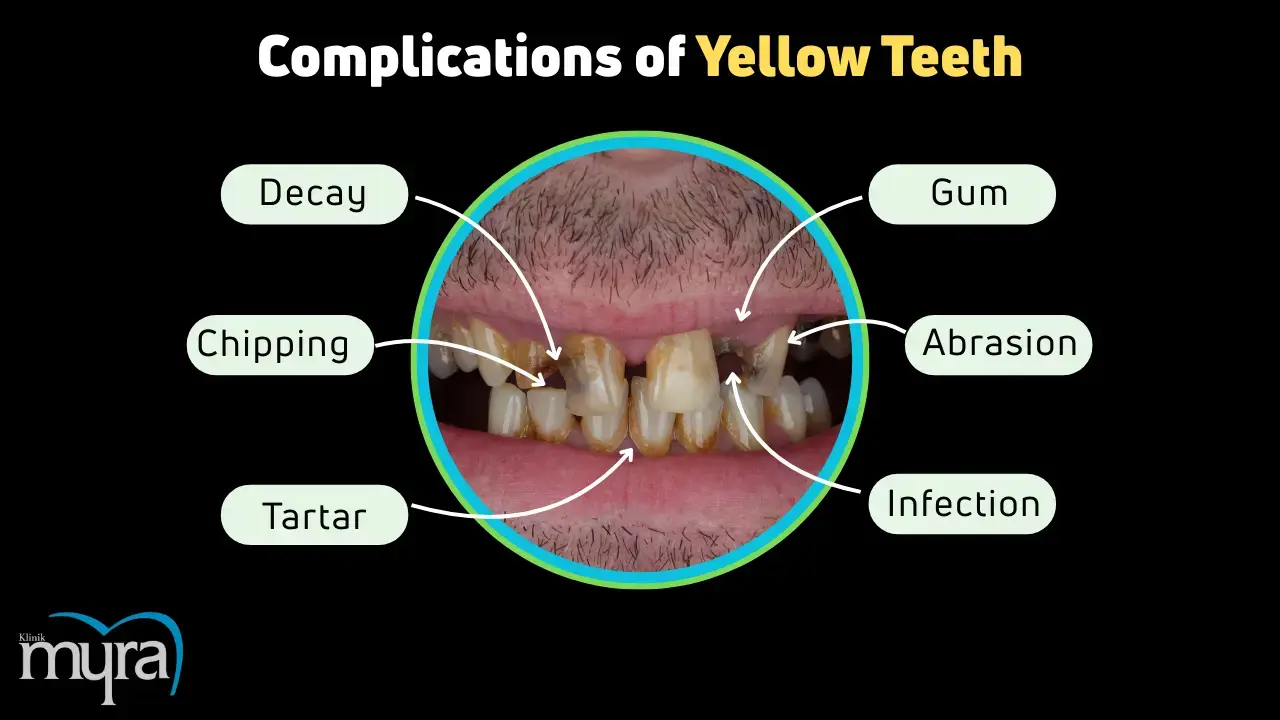
Is Yellow Teeth a sign of Poor Oral Health?
Yes, yellow teeth are a sign of poor oral health due to the buildup of plaque or tartar. Food and drink particles adhere to teeth and create plaque, a sticky layer of bacteria. Poor oral hygiene routines, such as inadequate brushing, inconsistent flossing, and neglecting recurring dental check-ups, allow plaque and tartar to accumulate on teeth, directing to stains and discolouration.
Poor oral hygiene leads to gum infection and tooth decay, further contributing to discolouration. Consuming staining substances such as coffee, tea, and tobacco exacerbates the problem. Preserving good oral hygiene practices, such as regular brushing, flossing, and dental check-ups, prevents yellow teeth and ensures oral health.





